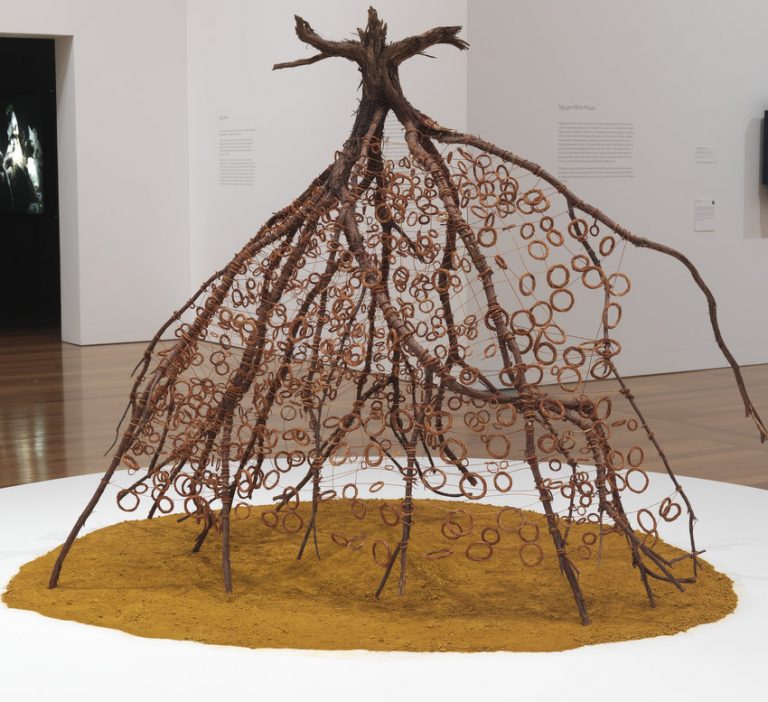We acknowledge the Traditional Owners of the land on which the Queensland Art Gallery | Gallery of Modern Art stands and recognise the creative contribution First Australians make to the art and culture of this country.

Shirley Macnamara / Indjalandji/Alyawarr / Australia b.1949 / Wingreeguu (installation view) 2012 / 190 x 241 x 160cm / Spinifex (Triodia longiceps), turpentine bush (Acacia lysiphloia), yellow ochre / Commissioned for APT7. Purchased 2013. Queensland Art Gallery Foundation Grant / Collection: Queensland Art Gallery | Gallery of Modern Art / © Shirley Macnamara
Shirley MacnamaraWingreeguu 2012
Not Currently on Display
As a child, Shirley Macnamara’s family sometimes lived in wingreeguu — a temporary bush shelter made by the Indilandji/Dhidhanu/Alyawarre people as they travelled across the land.
Macnamara travelled with her parents while they worked with cattle, and she remembers the comfort and protection that the shelter provided. The upturned turpentine tree’s rounded shape was ideal, and covered with spiky, dense spinifex clumps, protected them from the wind and rain.
After use, these shelters were abandoned and often destroyed by the weather or by seasonal fires, but if they survived, they could be repaired with newly grown spinifex and used by other travellers. The rings of spinifex in this work represent storylines or links to who we are and where we come from.
Shirley Macnamara runs a thriving cattle property with her son and his family near Mount Isa in western Queensland. She has close ties with Camooweal and the surrounding country through her mother’s Indjalandji people, and with Alyawarr lands, particularly Lake Nash, through her father.
Macnamara started painting in 1987, but began to experiment with weaving in 1992. She is well known for the guutu (vessels) she makes using combinations of synthetic and natural materials. In particular, she likes to work with spinifex (Triodia pungens), a tough, spikey native grass commonly found in the driest parts of Australia.
Spinifex’s long roots help keep the soil together so that the sand does not spread and create more desert. For Macnamara, spinifex embodies strength and utility, and she uses it to create tactile sculptures that reflect her surroundings, culture and history, as well as personal experiences and memories.
Discussion Questions
1. What does this artwork tell us about the place the artist is from?
2. The artist uses spinifex to represent strength and utility. Do you know of other plants that have special qualities?
3. Consider the design of this artwork, the shape and structure. The rounded shape was used for protection from wind and rain. Can you think of other rounded shapes that have been used for shelters?
Activities
1. With a partner collect materials from your environment (natural and found) and make a three-dimensional model shelter. Try to repeat a shape to create a pattern on the outside of the shelter. Think about what you would need to shelter from. Share with others why you designed your shelter in this way.
2. Consider the patterns that Macnamara has used to make her Wingreeguu 2012. Lines and circles feature prominently. Take photos of your own house, inside and out, and use Photoshop to create a layered drawing that includes patterns inspired by the patterns in your house (i.e. on fabrics, tiles, carpets, curtains, china, and furniture).